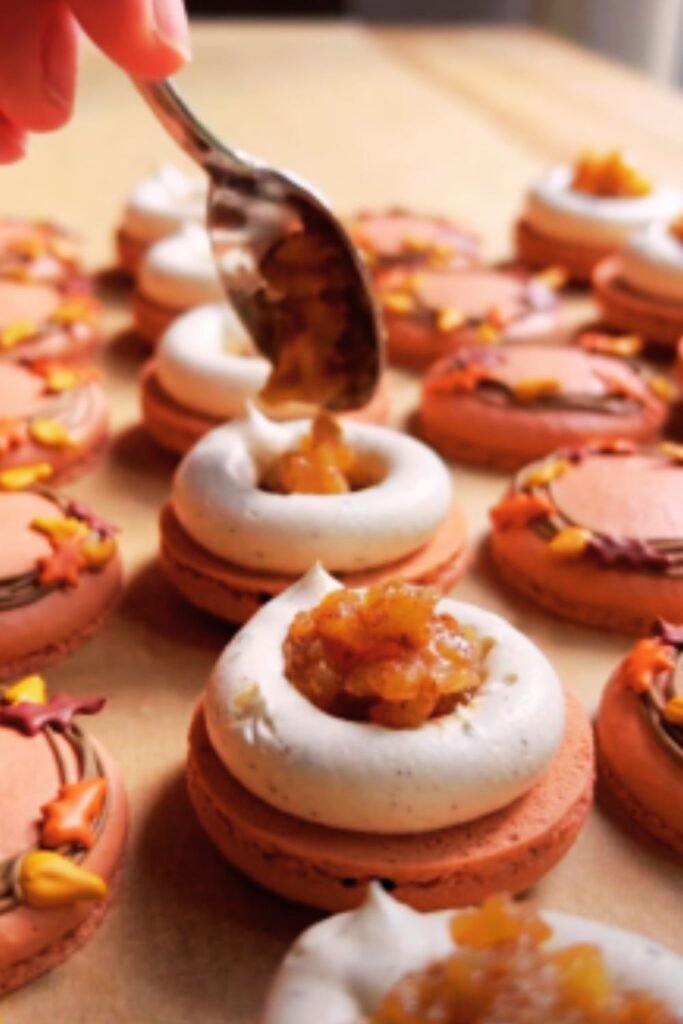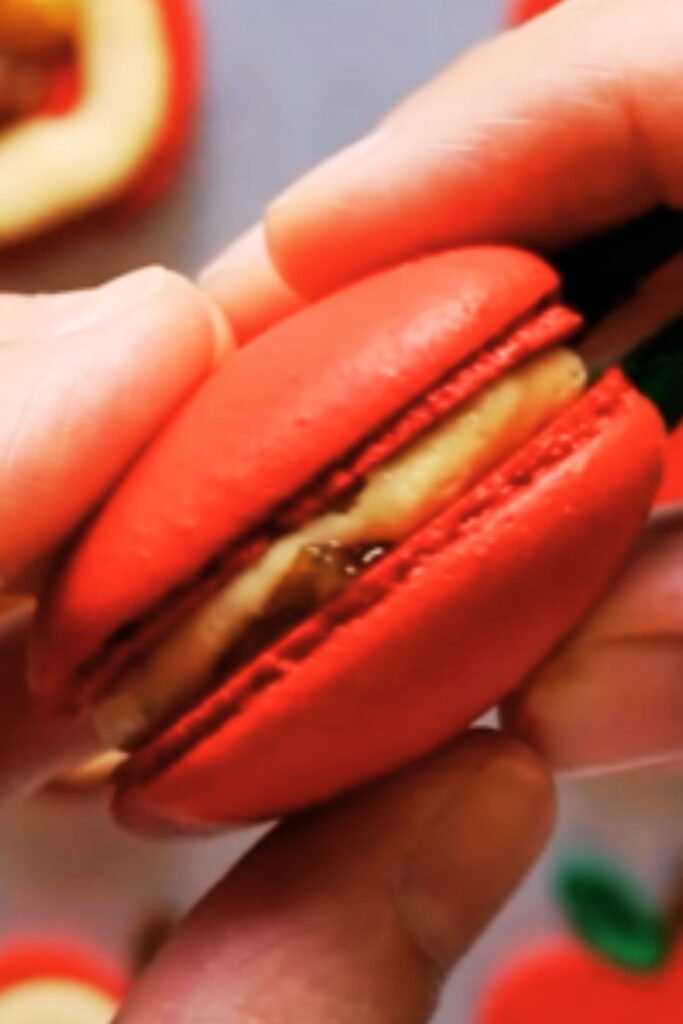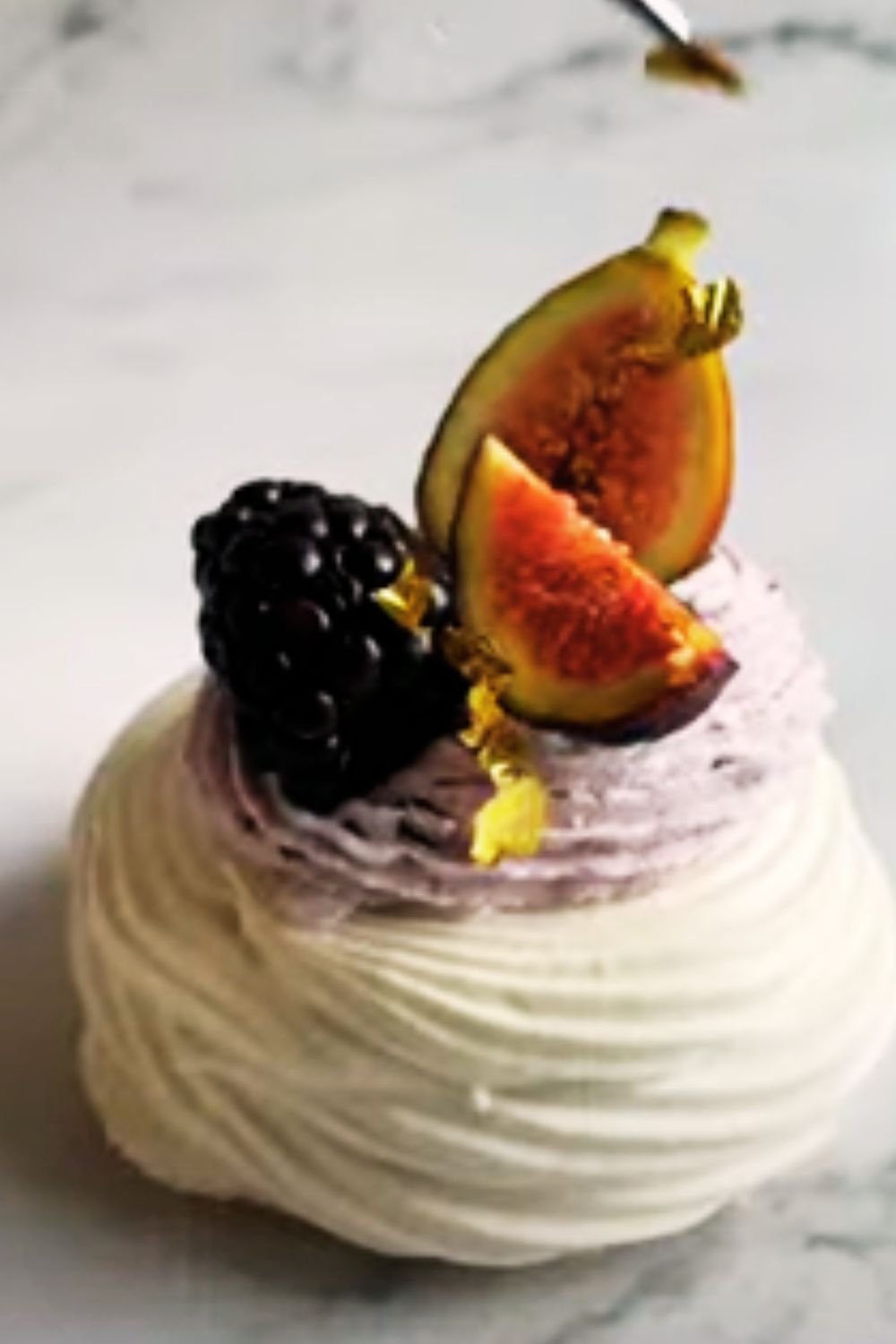There’s something magical about the first crisp autumn day when the leaves begin to change and the air carries that distinctive fall scent. For me, this season has always been about comfort, warmth, and indulging in the rich flavors that define this time of year. And what better way to embrace the essence of fall than with apple butter macarons? These delicate French cookies infused with the concentrated flavor of spiced apples create a perfect harmony of textures and tastes that will impress even the most discerning palate.
I still remember my first attempt at making these sophisticated treats. The kitchen was filled with the aroma of simmering apples and warm spices as I anxiously watched my macaron shells rise in the oven. When I finally assembled them with the homemade apple butter filling, that first bite was nothing short of revelatory—crisp shells giving way to chewy centers, complemented by the smooth, intense apple filling.
In this comprehensive guide, I’ll walk you through everything you need to know to create these seasonal delights in your own kitchen. From crafting the perfect macaron shells to preparing a rich, flavorful apple butter filling, I’ll share all my hard-earned tips and tricks to ensure your success.
Understanding the Magic of Macarons
Before diving into our recipe, let’s explore what makes macarons so special and, admittedly, a bit challenging to master.
French macarons are meringue-based confections made with almond flour, egg whites, and sugar. They feature smooth, domed tops with distinctive “feet” (the ruffled edges at the base), and a chewy interior sandwiched between two cookies. The perfect macaron achieves a delicate balance: crisp exterior, chewy interior, and a harmonious filling that complements the almond-forward shells.
The Science Behind Perfect Macarons
Macarons rely on some fascinating food science principles:
Meringue Structure The backbone of macarons is a stable meringue. When egg whites are whipped, the proteins unfold and create a network that traps air bubbles. This structure gives macarons their characteristic texture and rise.
Macaronage This French term refers to the specific folding technique used to incorporate the dry ingredients into the meringue. It’s arguably the most crucial step in achieving the right consistency—too little mixing results in peaked shells, while over-mixing creates flat, cracked cookies.
Resting Period The resting time before baking allows a skin to form on the piped macarons, which helps create the signature “feet” during baking. This skin prevents the top from rising too quickly while allowing the bottom to expand.
Essential Ingredients for Apple Butter Macarons
For macaron shells:
- 100g aged egg whites (approximately 3 large eggs, separated and left at room temperature for 24 hours)
- 100g granulated sugar
- 200g confectioners’ sugar
- 110g almond flour
- 1 tsp ground cinnamon
- ¼ tsp ground nutmeg
- Pinch of cloves
- Brown gel food coloring (optional)
For homemade apple butter:
- 4 lbs apples (preferably a mix of Honeycrisp, Granny Smith, and Gala)
- 1 cup apple cider
- ¾ cup brown sugar
- ¼ cup granulated sugar
- 2 tbsp fresh lemon juice
- 2 tsp ground cinnamon
- ½ tsp ground nutmeg
- ¼ tsp ground cloves
- ¼ tsp salt
For apple butter buttercream:
- 1 cup unsalted butter, softened
- 2½ cups confectioners’ sugar
- ⅓ cup homemade apple butter
- 1 tsp vanilla extract
- ¼ tsp salt
Equipment You’ll Need
Having the right tools makes all the difference when creating these delicate treats:
- Food processor
- Fine-mesh sieve
- Kitchen scale (for precise measurements)
- Stand mixer with whisk attachment
- Silicone spatula
- Piping bags
- Round piping tip (#12 works well)
- Silicone baking mats or parchment paper
- Templates for consistent sizing (optional)
- Slow cooker (for apple butter)
- Immersion blender
Preparing Homemade Apple Butter

The foundation of our macaron filling is a rich, concentrated apple butter. While you could use store-bought, nothing compares to the depth of flavor achieved through making your own.
Step-by-Step Apple Butter Process
- Prepare the apples: Wash, core, and chop the apples into 1-inch chunks (no need to peel).
- Combine ingredients: Place apples in a slow cooker with apple cider, sugars, lemon juice, and spices.
- Initial cooking: Cook on low for 10 hours, stirring occasionally. The mixture should turn deep brown and reduce significantly.
- Blend: Use an immersion blender to create a smooth puree.
- Reduce further: Continue cooking with the lid slightly ajar to allow moisture to escape. Cook for an additional 2 hours or until the mixture is thick enough that a spoon drawn through it leaves a trail.
- Cool completely: Transfer to jars and refrigerate. The apple butter will thicken further as it cools.
This recipe yields about 3 cups of apple butter—more than you’ll need for the macarons, but the extras store beautifully and make wonderful gifts or accompaniments to breakfast toast.
Apple Butter Concentration Test
To ensure your apple butter is properly reduced:
- Place a small amount on a cold plate.
- Tilt the plate—if no liquid separates and runs off, it’s ready.
- The consistency should be similar to thick fruit preserves.
Mastering Macaron Shells
Now for the heart of our recipe: perfectly spiced almond shells that complement the apple butter filling.
Preparing the Dry Ingredients
- Process dry ingredients: In a food processor, pulse the almond flour, confectioners’ sugar, cinnamon, nutmeg, and cloves until well combined.
- Sift: Pass the mixture through a fine-mesh sieve to remove any larger particles. Repeat this process twice for ultra-smooth shells.
Creating the Perfect Meringue
- Begin whipping: In a stand mixer fitted with the whisk attachment, start beating the aged egg whites on medium speed until foamy.
- Add sugar gradually: Increase the speed to medium-high and add the granulated sugar one tablespoon at a time.
- Achieve stiff peaks: Continue whipping until the meringue forms stiff, glossy peaks. The meringue should be firm enough that you can hold the bowl upside down without it falling out.
- Add color: If using, add gel food coloring (never liquid, as it will alter the consistency) and beat just until incorporated.
The Critical Macaronage
- Add dry ingredients: Add one-third of the dry mixture to the meringue and fold gently with a spatula using a circular motion from the bottom up.
- Continue folding: Add the remaining dry ingredients in two more additions, folding until the batter reaches the proper consistency.
- Test consistency: The batter should flow like lava when lifted with the spatula. It should form a ribbon that dissolves back into the batter within 30 seconds.
Piping and Resting
- Prepare sheets: Line baking sheets with silicone mats or parchment paper. If using templates, place them underneath.
- Fill piping bag: Transfer the batter to a piping bag fitted with a round tip.
- Pipe shells: Hold the bag perpendicular to the sheet and pipe 1.5-inch circles, spacing them about 2 inches apart.
- Remove air bubbles: Once all shells are piped, firmly tap the baking sheets against the counter several times to release any trapped air bubbles.
- Rest: Allow the piped shells to rest at room temperature for 30-60 minutes until a skin forms. You should be able to lightly touch the top without batter sticking to your finger.
Baking to Perfection
- Preheat oven: While the shells rest, preheat your oven to 300°F (150°C).
- Bake: Bake one sheet at a time for 15-18 minutes. The shells should rise with visible “feet” and not wiggle when gently touched.
- Cool completely: Allow the shells to cool completely on the baking sheet before attempting to remove them.
Apple Butter Buttercream
While the shells cool, prepare your buttercream filling:
- Beat butter: In a stand mixer fitted with the paddle attachment, beat the softened butter until light and fluffy, about 3 minutes.
- Add sugar: Gradually add the confectioners’ sugar, mixing on low speed until incorporated.
- Add apple butter: Mix in the apple butter, vanilla extract, and salt until smooth and well combined.
- Adjust consistency: If the buttercream is too soft, add more confectioners’ sugar. If too stiff, add a tiny bit of cream or milk.
Assembly and Aging

Now comes the rewarding part—bringing all components together:
- Match shells: Sort your cooled shells into pairs of similar size.
- Fill: Transfer the buttercream to a piping bag and pipe a generous amount onto the flat side of one shell.
- Place apple butter: Create a small well in the center of the buttercream and add a small dollop (about ¼ teaspoon) of pure apple butter for an intense flavor burst.
- Sandwich: Gently place the second shell on top, pressing just enough to spread the filling to the edges.
- Mature: Place the assembled macarons in an airtight container and refrigerate for at least 24 hours. This “aging” process allows the flavors to meld and the texture to develop as moisture from the filling softens the shells slightly.
Serving Suggestions

Apple butter macarons are versatile treats that can be enjoyed in various ways:
- Serve with warm apple cider for a quintessential fall experience.
- Create a dessert board with these macarons as the star, accompanied by fresh apple slices, caramel sauce, and cinnamon sticks.
- Package in decorative boxes for thoughtful holiday gifts.
- Include as part of an afternoon tea service.
- Pair with hot chai tea or a spiced coffee drink.
Troubleshooting Common Macaron Issues
Even experienced bakers encounter challenges with macarons. Here are solutions to common problems:
| Issue | Possible Causes | Solutions |
|---|---|---|
| No feet | Insufficient resting time | Ensure shells form a skin before baking |
| Oven temperature too low | Use an oven thermometer to verify temperature | |
| Hollow shells | Undermixed batter | Fold batter slightly more during macaronage |
| Overbeaten meringue | Beat meringue just until stiff peaks form | |
| Cracked tops | Oven temperature too high | Reduce temperature by 10-15 degrees |
| Air bubbles in batter | Tap sheets firmly to release air bubbles | |
| Wrinkled shells | Too much moisture | Age egg whites, reduce humidity in kitchen |
| Underbaked | Increase baking time by 1-2 minutes | |
| Uneven feet | Uneven heat distribution | Rotate baking sheet halfway through baking |
| Drafty oven | Avoid opening oven door during baking | |
| Sticky bottoms | Underbaked | Increase baking time slightly |
| Removed too soon | Allow to cool completely before removing | |
| Grainy texture | Insufficiently sifted ingredients | Sift almond flour mixture 2-3 times |
| Coarse almond flour | Process almond flour finer before sifting |
Storage and Shelf Life
Properly stored, apple butter macarons will keep for:
- 3-4 days at room temperature in an airtight container
- 1 week refrigerated in an airtight container
- Up to 3 months frozen (defrost in the refrigerator overnight before serving)
For best flavor development, I recommend consuming them between 24-48 hours after assembly.
Seasonal Variations
While this recipe celebrates fall flavors, you can adapt it throughout the year:
- Winter: Add a pinch of ginger and star anise to the apple butter.
- Spring: Blend the apple butter with a touch of lavender.
- Summer: Mix in a small amount of fresh berry puree to the buttercream.
Frequently Asked Questions
Why do my macarons crack during baking? Cracking usually occurs when moisture gets trapped under the shell’s surface. Make sure your macarons have developed a proper skin during the resting period and that your oven isn’t too hot. An oven thermometer can help ensure accurate temperature.
Can I make these without a food scale? I strongly discourage it. Macarons require precision, and even small measurement variations can lead to failure. A kitchen scale is an inexpensive investment that dramatically improves your chances of success.
How can I tell if my batter is properly mixed? The “figure-8 test” is reliable: lift some batter with your spatula and try to draw a figure 8. The batter should flow continuously without breaking. When the batter settles back into the bowl, any peaks should disappear within 30 seconds.
Can I use store-bought apple butter instead? Absolutely! Choose a high-quality, thick apple butter without additives. You may need to reduce it further on the stovetop if it seems too thin.
My shells are sticking to the baking mat. What went wrong? Likely underbaking. When properly baked, macaron shells should release easily once completely cooled. If they’re sticking, try baking a minute or two longer next time.
Why did my macarons turn out hollow? Hollow macarons often result from overbeaten egg whites or improperly incorporated dry ingredients. Try to be gentler with your meringue and make sure your macaronage technique is correct.
Can I freeze assembled macarons? Yes! They freeze beautifully for up to 3 months. Thaw in the refrigerator overnight before enjoying.
Final Thoughts on Apple Butter Macarons
Mastering apple butter macarons requires patience and precision, but the results are well worth the effort. These elegant cookies capture the essence of fall in each bite—the spiced almond shell yielding to the concentrated apple filling creates a symphony of flavors and textures that’s simply irresistible.
I encourage you to embrace the process. Even if your first batch isn’t picture-perfect, they’ll likely still taste amazing. With each attempt, you’ll refine your technique and develop an intuitive understanding of the delicate balance that creates macaron magic.
When you present a plate of these sophisticated treats to friends and family, you’ll not only share a delicious dessert but also the culmination of your culinary skill and creativity. There’s something deeply satisfying about transforming simple ingredients into something so elegant and distinctly seasonal.
So heat up your oven, gather your ingredients, and prepare to fall in love with these apple-infused delights. As the aroma of spices fills your kitchen and the delicate shells rise in your oven, you’ll understand why macarons have captivated bakers for generations—and why this apple butter variation might just become your new autumn tradition.


